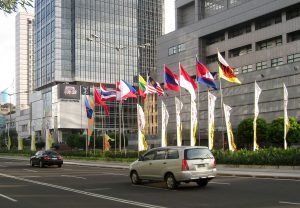On October 23, Bilahari Kausikan, the former permanent secretary of the Singaporean Ministry of Foreign Affairs, took part in a roundtable webinar organized by Singapore’s ISEAS-Yusof Ishak Institute. As part of the event, the ex-diplomat gave a talk on Southeast Asia’s future in an age of increasing great power competition.
Kausikan’s comments prompted a minor controversy when he suggested, almost as an aside, that the 10-member Association of Southeast Asian Nations (ASEAN) might one day be forced to expel Cambodia and Laos, two small nations that have become firmly ensconced in China’s economic and strategic orbit.
In his remarks, an edited excerpt of which was later published in article form, Kausikan pointed to the nations’ lack of engagement in the South China Sea controversy – or in Cambodia’s case, its active undermining of the regional consensus on the disputes at an ASEAN meeting in 2012.
The ex-diplomat accused the two countries of straying from an Indonesian slogan that held, “national resilience enhances regional resilience, and regional resilience enhances national resilience.” Over the past two decades, Cambodia’s Prime Minister Hun Sen has embraced Chinese largess as a foil against Western pressure for him to enact democratic reforms and improve human rights, while Laos, which shares a border with China, has been drawn into its economic orbit.
“To state things bluntly, I see Cambodia and Laos teetering precariously on the edge of making a parallel mistake as that which led to very tragic results for their countries in the late 1960s and 1970s,” Kausikan said.
“We shall see. They have some difficult choices to make. And if they should make wrong choices, they will confront ASEAN as a whole with difficult choices. We may have to cut loose the two to save the eight.”
Kausikan’s comments prompted considerable comment among Southeast Asia watchers online, and prompted both news coverage and analysis. It also elicited a blistering open letter, allegedly written by a group of former and serving Cambodian diplomats. Published by the de facto state media mouthpiece FreshNews, the letter described the former Singaporean diplomat as “attention seeking, inconsistent, and incoherent,” and accusing him of “destroying ASEAN unity and centrality.” The Chinese Embassy in Singapore also weighed in with a statement that accused Kausikan of “arrogance and prejudice” that “manifested as the hostility towards anything related to China.”
The call for the expulsion of ASEAN members is hardly unprecedented. In the first decade of the 2000s, it was quite commonplace to hear that military-ruled Myanmar should be expelled for its egregious human rights abuses. But despite this, the suggestion has since acquired the quality of a taboo, even if officials in Vietnam and the Philippines have long grumbled privately about Cambodia’s undermining of the regional consensus on the South China Sea disputes.
One reason for this is that ASEAN’s expansion in the 1990s – when it welcomed Vietnam (1995), Myanmar (1997), Laos (1997) and Cambodia (1999) as members – has made it seem close to synonymous with the generally recognized boundaries of Southeast Asia as a region. (The only nation remaining on the outside is Timor-Leste, which has applied for ASEAN membership). To jettison member-states would therefore risk undermining the fragile sense of Southeast Asian identity that ASEAN has promoted.
While the five nations that founded ASEAN in 1967 – Thailand, Indonesia, Malaysia, Singapore and the Philippines – were united by a common interest in resisting communist advances, the organization’s post-Cold War expansion has made its interests more diffuse. As Amitav Acharya has argued, the expansion of ASEAN’s membership had a paradoxical effect. While making “Southeast Asia” look more like a coherent concept, it added to ASEAN’s political diversity, making it trickier to reach consensus on key issues – including China.
In recent years, as China has used its economic sway over member-states like Laos and Cambodia to undermine ASEAN unity on maritime and territorial disputes, many observers have argued that the expansion of ASEAN was a mistake: that it stretched ASEAN’s internal interests beyond the point of coherence. As Kausikan put it, “One of the mistakes ASEAN made was expansion without adequate socialization of new members”: which is to say, without socializating them into viewing regional and national interests as intimately connected.
Philip Bowring made a similar point in his 2019 book Empire of the Winds: The Global Role of Asia’s Great Archipelago, in which he argued that the most logical coalition of interests within ASEAN bound together the maritime nations plus Vietnam, which shared many of their concerns about China’s assertiveness in the maritime domain.
To be sure, Kausikan made it clear that kicking out a member was not something that was likely to happen anytime soon: that it was a last resort if ASEAN’s coherence and survival was on the line. It was also possible that Cambodia and Laos, recognizing China’s grip over the upper reaches of the Mekong River, had good reasons to moderate their dependency on Beijing and become more proactive in their foreign policies. “If [expulsion] ever comes to pass, it will be for the future,” he said. “But it is worth thinking about even if only as a contingency. We should not dismiss the possibility out of hand.”
The expulsion of an ASEAN member would not be easy. It would require the consensus of the remaining nine members, and there is no guarantee that mainland states like Myanmar and Thailand, which have no direct interest in the South China Sea disputes, would support such a plan. This alone ensures that the situation would have to worsen considerably before such an option is considered seriously.

































